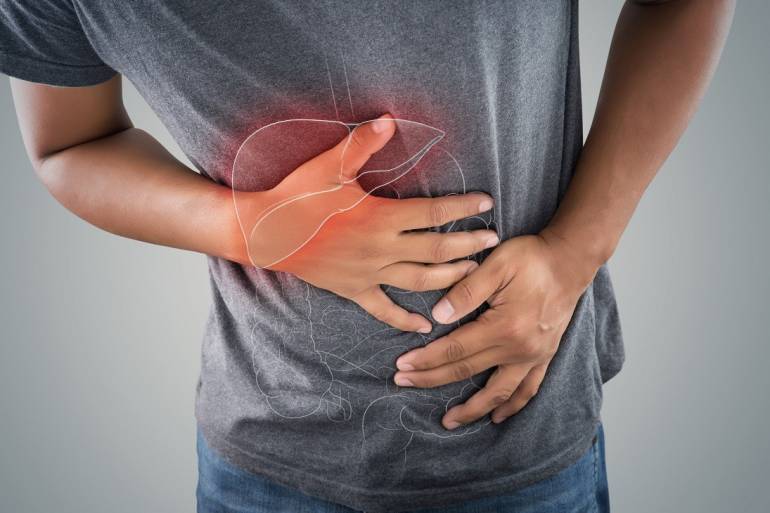Phospholipids and silymarin – a unique combination of two substances that protect and regenerate the liver. What properties do these substances have? Where do they occur and how to use them? Who should reach for preparations in the silymarin-phospholipid complex?
The liver is a very hard-working, but also sensitive organ. It performs dozens of functions, in its cells there are thousands of chemical reactions important for the functioning of the entire body. It metabolizes and stores carbohydrates, processes proteins and lipids. Produces bile, takes part in digestion of food, detoxifies and detoxifies the body. It is responsible for some immune processes and converts heme from red blood cells to bilirubin. And these are just a few of the many important functions of the liver.
Drugs, alcohol, improper diet, stress, nicotine, sedentary lifestyle, past illnesses – there are many factors that negatively affect the work of this organ. And a strained liver does not hurt, because it is not innervated. Liver damage can develop for years without producing any specific symptoms. Digestive problems, bloating and abdominal pain appear. Non-specific symptoms, such as fatigue, general weakness and malaise, are added. Being in the risk group, it is worthwhile in such a case to do laboratory tests for bilirubin and liver enzyme levels (ALAT and AspAT). Elevated values of these parameters are an important alarm signal.
Liver damage – where does it come from?
A hard-working liver has no time for regeneration. The burden of intensive processes of detoxification and metabolism of many substances has an adverse effect on the functioning of hepatocytes (liver cells). Particularly dangerous are long-term drug use, regular exposure to alcohol, smoking, a history of viral hepatitis and a heavy diet. These factors can lead to changes in the structure of this organ and its malfunction. Over time, serious damage, fibrosis and steatosis of the liver occur.
When noticed early enough, changes in the structure and function of this organ offer a good chance for regeneration. However, multidirectional action is needed to restore efficient liver function. In addition to the use of drugs to protect and regenerate hepatocytes, it is necessary to change the diet and, above all, avoid factors that have a negative impact on the liver. What substances of natural origin are worth reaching for in order to, on the one hand, prevent liver damage and, on the other, support its regeneration?
Silymarin – how does it work?
Silymarin is the collective name for a number of chemicals extracted from the seeds of the spotted thistle(Silybum marianum). It is a complex of flavonolignans with antioxidant and anti-inflammatory properties. It stimulates the production of proteins in the damaged liver, while inhibiting the penetration of toxins into the cells and fibrosis of the organ.
Check out: over-the-counter liver medications
How does silymarin from milk thistle work?
- has antioxidant properties
- Accelerates regeneration of damaged liver cells
- Stabilizes, strengthens and protects the cell membranes of hepatocytes
- Contributes to the production of new liver cells.
Silymarin has a two-way effect – on the one hand, it stimulates liver cells to rebuild and protects them, and on the other, it inhibits the processes that lead to their damage. In addition, it prevents the formation of gallstones.
Phospholipids for better liver function
Another substance of natural origin with hepato-protective effects is phospholipids extracted from soybeans. These are fatty acid esters that have the ability to be incorporated into the biological membranes of various cells, thereby increasing their fluidity and intensifying transport between cells. In the liver, phospholipids stabilize the cell membranes of hepatocytes.
How do soy phospholipids work?
- Build into the cell membranes of hepatocytes, stabilizing them and facilitating intercellular transport
- stimulate bile production
- intensify the work of enzymes
- They help restore normal hepatocyte function.
Silymarin-phospholipid complex – a unique combination of
Both the use of silymarin from milk thistle and soy phospholipids have beneficial effects on liver function. However, studies show that the combination of these two substances enhances their beneficial effects. In what way? In the presence of phospholipids, silymarin is better absorbed. This is a big advantage, as it has greater bioavailability and can be used in smaller doses, while enhancing the therapeutic effect.
The combination of these two compounds into a silymarin-phospholipid complex has other advantages. In liver cells, it has a higher lipophilicity, which directly affects liver protection and function. The combined properties of silymarin and phospholipids also result in improved hepatocyte function, lowering total cholesterol, triglycerides and bilirubin.
For what and when to use preparations with silymarin-phospholipid complex?
The synergistic action of the silymarin-phospholipid complex is helpful in treatment (and prevention):
- Drug-induced liver damage, especially with the use of large amounts of drugs that “pass” through the liver and are metabolized there
- Liver steatosis caused by obesity, diabetes, alcohol or metabolic syndrome
- viral hepatitis (hepatitis of various types).
- Fibrosis and cirrhosis of the liver, resulting from a variety of conditions within this organ
- Degenerative changes associated with heavy alcohol consumption
- Exposure to toxins and poisoning of the body.
A drug that contains a silymarin-phospholipid complex is Essylimar®. It is an over-the-counter preparation that prevents damage and regenerates the liver. In addition, it accelerates the formation of new hepatocytes and stimulates the production of liver enzymes. The preparation is used supportively in liver disorders. Sylimarol also has a similar effect.
The natural properties of silymarin and phospholipids are helpful in preventing and treating liver damage caused by various causes. However, combining them into a silymarin-phospholipid complex provides additional therapeutic effects.







